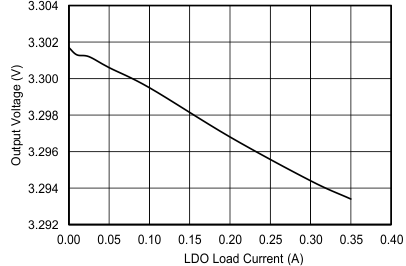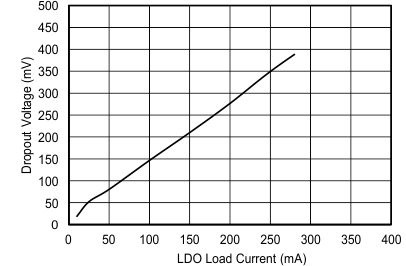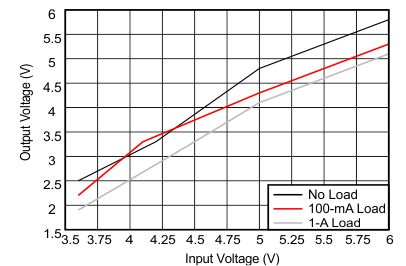| VIN (INPUT POWER SUPPLY) |
|
Operating input voltage |
Normal mode, after initial start-up |
3.6 |
14 |
40 |
V |
|
Shutdown supply current |
V(EN1) = V(EN2) = 0 V, 25°C |
|
2 |
7 |
μA |
|
Initial start-up voltage |
|
6 |
|
40 |
V |
| ENABLE AND UVLO (EN1 AND EN2 PINS) |
|
Enable low level |
|
|
|
0.7 |
V |
|
Enable high level |
|
2.5 |
|
V |
| V(VIN)(f) |
Internal UVLO falling threshold |
Ramp V(VIN) down until output turns OFF |
2 |
2.6 |
3 |
V |
| V(VIN)(r) |
Internal UVLO rising threshold |
Ramp V(VIN) up until output turns ON |
2.2 |
2.8 |
3.2 |
V |
| BUCK REGULATOR |
|
Operating: non-switching supply |
V(FB1) = 0.83 V, V(VIN) = 12 V, 25°C |
|
110 |
140 |
μA |
|
Output capacitor |
ESR = 0.001 Ω to 0.1 Ω, large output capacitance may be required for load transient |
10 |
|
|
μF |
| BUCK REGULATOR: HIGH-SIDE MOSFET |
|
On-resistance |
V(VIN) = 12 V, V(SW) = 6 V |
|
127 |
250 |
mΩ |
| BUCK REGULATOR: ERROR AMPLIFIER |
|
Input current |
|
|
50 |
|
nA |
|
Error-amplifier transconductance (gm) |
–2 µA < I(COMP) < 2 µA, V(COMP) = 1 V |
|
310 |
|
µS |
|
Error-amplifier transconductance (gm) during soft start |
–2 µA < I(COMP) < 2 µA, V(COMP) = 1 V
V(FB1) = 0.4 V |
|
70 |
|
µS |
|
Error-amplifier dc gain |
V(FB1) = 0.8 V |
|
100 |
|
dB |
|
Error-amplifier bandwidth |
|
|
6000 |
|
kHz |
|
Error-amplifier source or sink |
V(COMP) = 1 V, 100-mV overdrive |
|
±27 |
|
μA |
|
COMP to switch-current transconductance |
|
|
10.5 |
|
S |
| Vref1 |
Voltage reference for FB1 pin |
Buck regulator output: 3.6 V to 10 V |
0.788 |
0.8 |
0.812 |
V |
| BUCK REGULATOR: CURRENT-LIMIT |
|
Current-limit threshold |
V(VIN) = 12 V, TJ = 25°C |
4 |
6 |
|
A |
| BUCK REGULATOR: TIMING RESISTOR AND EXTERNAL CLOCK (RT/CLK PIN) |
| RT/CLK |
High threshold |
|
|
1.9 |
2.2 |
V |
| RT/CLK |
Low threshold |
|
0.5 |
0.7 |
|
V |
| BUCK REGULATOR: INTERNAL SOFT START TIMER |
| IS(SS) |
Soft-start source current |
V(SS) = 0 V |
1 |
2 |
4 |
μA |
| LDO REGULATOR |
| ΔVO(ΔVI) |
Line regulation |
V(VIN) = 6 V to 30 V, I(LDO_OUT) = 10 mA, V(LDO_OUT) = 3.3 V |
|
|
20 |
mV |
| ΔVO(ΔIL) |
Load regulation |
I(LDO_OUT) = 10 mA to 200 mA, V(VIN_LDO) = 14 V, V(LDO_OUT) = 3.3 V |
|
|
35 |
mV |
VDROPOUT
(V(VIN_LDO) – V(LDO_OUT)) |
Dropout voltage |
I(LDO_OUT) = 200 mA |
|
300 |
450 |
mV |
| I(LDO_OUT) |
Output current |
V(LDO_OUT) in regulation |
0 |
|
280 |
mA |
|
Error-amplifier dc gain |
|
|
800 |
|
V/V |
| V(VIN_LDO) |
Operating input voltage on VIN_LDO pin |
Buck regulator is in regulation and supplying at least LDO output plus dropout voltage VDROPOUT |
3 |
|
20 |
V |
| Vref2 |
Voltage reference for FB2 pin |
V(LDO_OUT) = 1.2 V to 5 V |
0.788 |
0.8 |
0.812 |
V |
| ICL(LDO_OUT) |
Output current limit |
V(LDO_OUT) = 0 V (LDO_OUT pin is shorted to ground.) |
280 |
|
1000 |
mA |
| IQ(LDO) |
Quiescent current |
V(VIN) > 9 V, V(EN1) = 0 V, V(EN2) = 5 V, I(LDO_OUT) = 0.01 mA to 0.75 mA, TJ = 25°C |
|
28 |
75 |
μA |
| PSRR |
Power supply ripple rejection |
V(VIN_LDO)(rip) = 0.5 VPP, I(LDO_OUT) = 200 mA, frequency = 100 Hz, V(LDO_OUT) = 5 V and V(LDO_OUT) = 3.3 V |
|
60 |
|
dB |
| PSRR |
Power supply ripple rejection |
VVIN_LDO(rip) = 0.5 VPP, I(LDO_OUT) = 200 mA, frequency = 150 kHz, V(LDO_OUT) = 5 V and V(LDO_OUT) = 3.3 V |
|
30 |
|
dB |
|
Output capacitor |
ESR = 0.001 Ω to 100 mΩ, large output capacitance may be required for load transient, V(LDO_OUT) ≥ 3.3 V |
1 |
|
40 |
μF |
| ESR = 0.001 Ω to 100 mΩ, large output capacitance may be required for load transient, 1.2 V ≤ V(LDO_OUT) < 3.3 V |
20 |
|
40 |
μF |
| LDO REGULATOR: RESET (nRST PIN) |
|
RESET threshold |
V(LDO_OUT) decreasing |
88% |
92% |
95% |
|
| VOH |
Output high |
Reset released due to rising LDO_OUT, V(LDO_OUT) ≥ 3.3 V, IOH = 100 µA |
–5% × V(LDO_OUT) |
|
|
V |
| VOL |
Output low |
Reset asserted due to falling LDO_OUT, IOL = 1 mA |
0 |
0.045 |
0.4 |
V |
| OVERTEMPERATURE PROTECTION |
| TSD |
Thermal-shutdown trip point |
|
|
155 |
|
ºC |
| Thys |
Hysteresis |
|
|
10 |
|
ºC |






